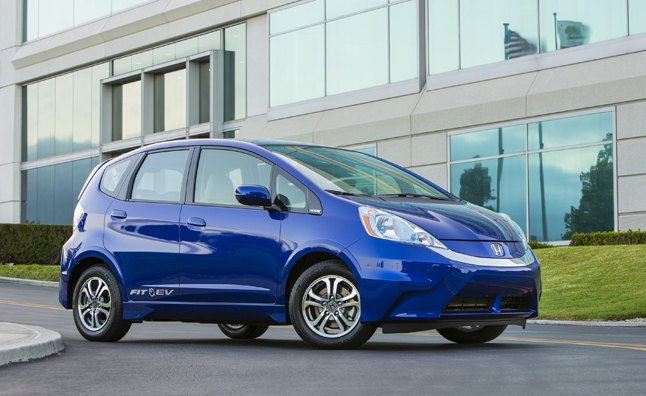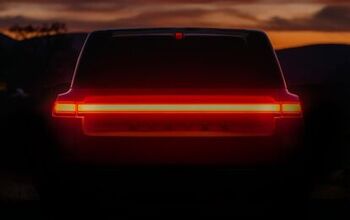Electric Car Revolution: 10 Future EVs

The Chevrolet Volt and Nissan Leaf initiated a whole new movement in the auto industry. With the realization that an all-electric vehicle can be useful in everyday driving situations thanks to a large battery and more efficient fast charging technology, automakers are hopping on the electric vehicle bandwagon.
“Overall automakers want to be prepared,” says Devin Lindsay, an automotive powertrain analyst from IHS Automotive. “EVs are another tool for automakers to reach out to consumers” he says, mentioning that automakers are taking EVs seriously, rather than just putting a bunch of batteries and motors in an existing product.
It’s interesting to see how automakers make electric cars from the ground up to use only electric propulsion. For example Tesla and Cadillac are all making vehicles that will exclusively be used with an electric powertrain. Others are modifying their current successful vehicles to EVs. Lets take a look at the different EVs that will be arriving soon (or are already here), and learn a bit about the new technology behind it.
The cheap and practical Honda Fit, might be losing a bit of its best elements by going the electric route. Like a other EVs out there, it won’t even be available for purchase, meaning you’ll have to lease it on Honda’s terms if you want to get on the EV bandwagon.
Even so, the Fit still plays a solid role in the EV world. A charging time of less than 3-hours makes the Fit charge up faster than almost all of its competition. Thanks to a 20-kWh lithium-ion (Li-ion) battery, the Fit can drive up to 82 miles, besting its biggest rival, the Mitsubishi i-MiEV by 20 miles per charge.
Furthermore, the Honda Fit EV will try to emulate the characteristics of its fun-to-drive gas-powered brother, with a 123-hp and 188 lb-ft electric motor.
The Honda Fit EV is available for lease at $389 a month for three years, and will reach California and Oregon this summer, and other states early next year. It’s also important to mention that the Fit EV will be limited to only 1,100 models.
For more information on the Honda Fit EV, take a look at our review and video
Cadillac’s Converj concept will be seeing its way as a production car named the Cadillac ELR. By using some touched up elements from GM’s innovative Chevrolet Volt, the ELR is expected to add a much needed touch of luxury to electric vehicles.
“The ELR will take advantage of the baseline propulsion system that the Chevy Volt pioneered,” says David Caldwell of Cadillac Communications. “There could be some minor differences in the final product as it’s still in development. But the ELR is destined to use EREV (extended range electric vehicle) tech in a similar fashion.”
By using an extended range electric powertrain the ELR will get a significant range advantage on the other vehicles on this list.
“Extended-range electric propulsion means that the car is capable of total driving range much like any conventional vehicle – with the majority of typical daily driving using only battery power,” said Caldwell. “If and when the battery depletes, the small on-board engine activates to achieve total range far in excess of “battery-only” cars.”
The ELR will feature more Cadillac tech, in the form of the CUE infotainment system, which debuted on the Cadillac XTS sedan.
The ELR is an eagerly anticipated vehicle, since its yet another stylish coupe from the American brand. Expect it within 18-24 months. Details are still scarce on the ELR, and there are no estimates for ranges, but Chevy’s Volt is able to travel 38 miles before the on board engine kicks in to provide more range. In total, the Volt is able to travel 382 miles. It will be interesting to see how the range changes when the technology is used in Cadillac’s coupe.
Tesla’s Model S sedan is the brand’s second vehicle to date. While the Roadster is no long available, Tesla has moved to more practical vehicles, like this Model S.
The Model S continues to expand on Tesla’s past performance with the Roadster, and puts a priority on driving range. In an interesting twist, Tesla offers the Model S with three different sized batteries, each one makes a huge impact in terms of range, and pricing.
The three batteries offer different stats on performance as well. The 40kW battery is said to have a range of 160 miles, and a 0-60 time of 6.5 seconds. The 60kW is supposed to be able to reach 230 miles on a single charge, and can hit 60 mph in 5.9 seconds. Finally the 85kW battery can go a whopping 300 miles on a charge, and is able to reach 60 mph in 4.4 seconds.
The Model S starts at $49,900 for the smallest battery, and can reach prices beyond $84,900 with the biggest battery. The Tesla Sedan also features some of the latest automotive technology, including some a geek-tastic 17-inch center-console touchscreen.
Tesla also helps bring some piece of mind to those worried about battery issues by offering a standard 8-year, 100,000 mile warranty on the Model S.
While Tesla releases the Model S sedan this year, it will be late next year when they start production of its new family-friendly Model X. Just like the Model S, the Model X will be available with a variety battery sizes and drive-trains which will affect both range and the price tag.
As with other electric vehicles from Tesla, the Model X will be quite fast from a standstill, apparently making the sprint to 60 mph in less than 5 seconds. Of course, this is thanks to an available all-wheel drive system. Even with the all-wheel drivetrain, the Model X is expected to only lose about 10% of its range, in comparison to the Model S.
Making the Model X stand out even more is its ‘falcon’ wings, which allow rear-seat passengers easy access into the car.
Pricing and official range numbers are still not available, but expect more details next year.
Ford’s Focus is another high-profile contender in the EV gauntlet and has just started hitting the show-rooms. Ford is looking to sell 5000 of the all-electric compact a year.
Thanks to its impressive range numbers, the Focus EV is quickly proving to be a solid contender in the same space as the Leaf and Volt. According to Ford, each full charge can get you up to 76 miles, which is just three miles further than the Nissan Leaf.
There are a few things that make the Focus really stand out against its rivals. The three and a half hour charging time on the 240-volt charger, means it charges a bit faster than its competition, and with an electric motor that boasts 141 horsepower and 188 lb-ft of torque, the Focus can move pretty quickly too.
Buyers of Ford’s all-electric compact will also be able to use the MyFord mobile app, which allows users track and schedule the charging of the Focus, remotely. The app also lets you plan your trips, monitor your charge, find the nearest charging station. The MyFord mobile app also helps you get the most out of each charge, by providing you the most-efficient route to your destination. To learn more about the new Ford Focus Electric, check out our review, and video.
The Scion iQ is a cheap, mini-subcompact with 4-seats, and its mind-boggling to imagine how they would squeeze some batteries in there. But sources indicate that an iQ EV is on its way, and will be on the roads by the end of the year.
However, it seems like the iQ EV will be limited, explicitly only available to fleet services. Word from Scion is that the iQ EV will be primarily used in car-sharing fleet, like Zipcar.
While Toyota is working with American electric car company Tesla Motors to build its RAV4 EV, the iQ is expected to be an internal project using Toyota’s own batter technology.
The iQ EV will also be available in Europe, and is expected to have a 65 mile range.
The Spark will be the first all-electric General Motors vehicle since the EV1 was discontinued and destroyed back in 2003.
The Spark EV will use a 114-hp electric motor, a whole 31 more than the standard Spark. Of course, that extra power should help offset the additional weight of the batteries used, and can help make the Spark as fun to drive as the Honda Fit EV.
The Spark uses nanophosphate lithium-ion batteries produced by A123 Systems. This should help to reduce charge times and can increase the usable amount of the battery’s energy, making it more efficient. This is the same kind of high-tech batteries used by Fisker in the expensive Karma.
Chevrolet says that the Spark will arrive in 2013 in limited numbers, and to select markets.
Toyota is bringing it’s RAV4 into the electric car circus, and with a MSRP of $49,800, it will likely be a cheaper alternative to the Tesla Model X crossover.
The new all-electric RAV4 is equipped with a 154-hp motor, which has two driving modes, Sport, and Normal. In the normal mode, the RAV4’s motor provides a maximum of 218 lb-ft of torque and is limited to a maximum speed of 85 mph. When Sport mode is enabled, the torque number spikes up to 273 lb-ft of torque and the RAV4 can get to a maximum speed of 100 mph.
The front-wheel drive RAV4 EV also gets surprisingly good 0-60 times for a 4,000 lb crossover. Sixty mph from a stop comes in 8.6 seconds in Normal mode, and 7.0 in sport mode.
Even with all that performance Toyota says that the RAV4 will be able to travel a distance of 100 miles on a single charge. That’s thanks to a 41.8 kWh, Tesla sourced battery. Charging times are estimated to be around 6-hours at the shortest, using the 240V charging station.
A LED lighting system helps reduce power consumption, and a low-drag body-kit helps the RAV4 get its impressive range.
Of course, Toyota knows that car buyers might be skeptical of the new technology. That’s why they have a pretty extensive battery warranty at 8-years/100,000 miles.
At the New York Auto show earlier this year, Infiniti showed off its LE electric car concept. However, Infiniti made sure to point out that this is a production intent concept, meaning that what was on show will be close to the actual version that’s expected to hit in two years. Not only does the Infiniti LE look great, but it packs some interesting and unique EV technology.
For starters, the LE Concept puts its batteries under the passenger compartment floor, which is aimed to improve the car’s center of gravity for enhanced handling and maximize trunk room. Additionally the LE’s 100 kW synchronous electric motor is rated at 134 horsepower and makes 240 lb-ft of torque, some numbers that put it up at the top of its class.
Finally, the Infiniti LE Concept is planning on using an advanced wireless charging station which will use an inductive energy flow to charge the car. Infiniti insists that the technology is safe for kids and pets, and can be safely installed in a garage. To help, Infiniti says that the car will be equipped with a smart parking assist technology, that will maneuver the car into the correct place to charge. It’s all impressive stuff, and while EVs are hoping you’ll stop pumping gas, the Infiniti LE is trying to help you to stop plugging your car in too.
Ford’s C-MAX will be coming to North America in two very distinct versions. The C-MAX hybrid will be using a traditional gas-electric powertrain, but perhaps the more interesting model will be the C-MAX Energi, which uses a plug-in hybrid technology.
“We project C-MAX Energi will have 20+ miles of “pure” electric-only range,” says Wesley Sherwood, from Ford’s Electrified Vehicles Communications team. That means that it’ll have about triple the range of the Prius Plug-in.
Thanks to Ford’s new powersplit technology, the C-MAX energy will also be able to go on pure-electric mode at faster speeds than any other plug-in hybrid.
When the batteries are depleted, the C-MAX’s frugal 2.0L engine kicks in, allowing the car to travel up to 550 miles on a single charge and tank.
Now that you’ve gone through our list of upcoming electric cars, why not take a look at 11 hybrid vehicles that are hitting dealers soon.

Sami has an unquenchable thirst for car knowledge and has been at AutoGuide for the past six years. He has a degree in journalism and media studies from the University of Guelph-Humber in Toronto and has won multiple journalism awards from the Automotive Journalist Association of Canada. Sami is also on the jury for the World Car Awards.
More by Sami Haj-Assaad









































Comments
Join the conversation